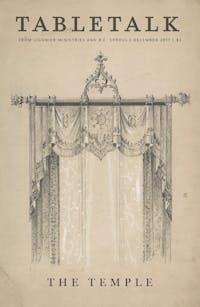
Request your free, three-month trial to Tabletalk magazine. You’ll receive the print issue monthly and gain immediate digital access to decades of archives. This trial is risk-free. No credit card required.
Try Tabletalk NowAlready receive Tabletalk magazine every month?
Verify your email address to gain unlimited access.
One of the three objects to stand in the Holy Place of the tabernacle of Israel was the golden lampstand. God’s command to make a lampstand for the sanctuary appears in Exodus 25:31–40 ( see also 37:17–24). The Hebrew word for “lampstand” is menorah, and it derives from a verb that means “to flame.” The name menorah simply underscores the utilitarian purpose of the lampstand: it is to give light to the priests who work in the Holy Place of the tabernacle.
In Exodus 25:40, God told Moses that the menorah was to be made specially and specifically “after the pattern for them, which is being shown you on the mountain.” In fact, the entire sanctuary and all its furnishings were to be built based on the pattern or blueprint provided from above (see v. 9). The tabernacle in full was to be modeled on something else. It was to be a replica of a celestial archetype, that is, the heavenly sanctuary. So, the very specifications for the menorah were given by God directly to Moses on Mount Sinai.
The lampstand was to be made of pure gold, and all of its various parts were to be hammered out of one solid lump of gold. Unattached equipment for the menorah, such as tongs and trays, were also to be made of pure gold. The lampstand and all its accoutrements together were to be made out of one “talent” of pure gold (v. 39). According to Exodus 38:24–31, the talent equals about three thousand shekels, or between fifty-three and seventy-nine pounds.
The design of the golden lampstand was formed around a central trunk with three branches on each side, thus equaling seven branches in all. It looked like a tree. In fact, its design was typical of stylized trees depicted in ancient Near Eastern art. In the ancient Near East, the tree in art signified life, prosperity, and productivity. For the people of God, the menorah in the temple symbolized the same thing: the life and blessings that God had given to His people. But also, the lampstand was to remind the Hebrew people of a particular tree.
As many scholars have acknowledged, the tabernacle/temple was planned and designed to remind worshipers of the garden in Eden as a sanctuary with Adam as its priest. In the midst of the garden-sanctuary was the tree of life. The menorah was symbolic not only of life, but of eternal life for the true people of God. It not only looked back to the tree of life in the garden, but it also anticipated the tree of life that stands in the new heavens and the new earth in Revelation 22. There, in that Edenic sanctuary of the new Jerusalem, the Apostle John has a vision of
the river of the water of life, bright as crystal, flowing from the throne of God and of the Lamb through the middle of the street of the city; also, on either side of the river, the tree of life . . . yielding its fruit each month. The leaves of the tree were for the healing of the nations. (Rev. 22:1–2)
It is also significant to note that the menorah was a seven-branched candlestick. The number seven in Hebrew culture often carried the idea of completeness and wholeness, and it may be that the number was to point to the concept of Sabbath completion. As such, it may be a reminder of the seven-day creation week in which God brought the first light into the world. For the Hebrew worshiper, the lampstand thus pointed to the past when the light of God broke into the world, and in the tabernacle it had a present application of pointing to the perfect light that God shone on the covenant community.

For the believer today, the menorah is an unnecessary object for worship because Jesus proclaimed, “I am the light of the world. Whoever follows me will not walk in darkness, but will have the light of life” (John 8:12). Indeed, Jesus is “the true light, which gives light to everyone” (1:9). And in the new Jerusalem, there will be no need of a menorah because “the city has no need of sun or moon to shine on it, for the glory of God is its light, and its lamp is the Lamb” (Rev. 21:23).
Finally, the Lord in His law gave a command to Aaron and his sons to tend to the lampstand “from evening to morning” (Ex. 27:21). This duty was to be done daily by the priests so that the lamp would burn continuously in the tent of meeting (27:20). Apart from the utilitarian usage, the continuous nature of the burning symbolizes God’s everlasting giving of life and light to His people . . . especially in the incarnation and work of Jesus Christ.
